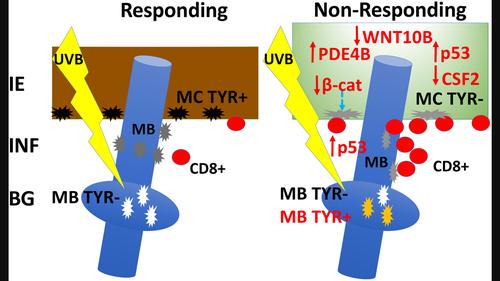当前位置:
X-MOL 学术
›
Pigment Cell Melanoma Res.
›
论文详情
Our official English website, www.x-mol.net, welcomes your feedback! (Note: you will need to create a separate account there.)
Vitiligo non-responding lesions to narrow band UVB have intriguing cellular and molecular abnormalities that may prevent epidermal repigmentation
Pigment Cell & Melanoma Research ( IF 4.3 ) Pub Date : 2024-02-11 , DOI: 10.1111/pcmr.13160 Nathaniel B. Goldstein 1 , Andrea Steel 1 , Landon Tomb 1 , Zachary Berk 1 , Junxiao Hu 2 , Velmurugan Balaya 3 , Laura Hoaglin 3 , Kavya Ganuthula 1 , Meet Patel 1 , Erica Mbika 1 , William A. Robinson 4 , Dennis R. Roop 1, 3 , David A. Norris 1, 3 , Stanca A. Birlea 1, 3, 5
Pigment Cell & Melanoma Research ( IF 4.3 ) Pub Date : 2024-02-11 , DOI: 10.1111/pcmr.13160 Nathaniel B. Goldstein 1 , Andrea Steel 1 , Landon Tomb 1 , Zachary Berk 1 , Junxiao Hu 2 , Velmurugan Balaya 3 , Laura Hoaglin 3 , Kavya Ganuthula 1 , Meet Patel 1 , Erica Mbika 1 , William A. Robinson 4 , Dennis R. Roop 1, 3 , David A. Norris 1, 3 , Stanca A. Birlea 1, 3, 5
Affiliation

|
We have discovered that human vitiligo patients treated with narrow-band UVB (NBUVB) demonstrated localized resistance to repigmentation in skin sites characterized by distinct cellular and molecular pathways. Using immunostaining studies, discovery-stage RNA-Seq analysis, and confirmatory in situ hybridization, we analyzed paired biopsies collected from vitiligo lesions that did not repigment after 6 months of NBUVB treatment (non-responding) and compared them with repigmented (responding) lesions from the same patient. Non-responding lesions exhibited acanthotic epidermis, had low number of total, proliferative, and differentiated melanocyte (MC) populations, and increased number of senescent keratinocytes (KCs) and of cytotoxic CD8+ T cells as compared with responding lesions. The abnormal response in the non-responding lesions was driven by a dysregulated cAMP pathway and of upstream activator PDE4B, and of WNT/β-catenin repigmentation pathway. Vitiligo-responding lesions expressed high levels of WNT10B ligand, a molecule that may prevent epidermal senescence induced by NBUVB, and that in cultured melanoblasts prevented the pro-melanogenic effect of α-MSH. Understanding the pathways that govern lack of NBUVB-induced vitiligo repigmentation has a great promise in guiding the development of new therapeutic strategies for vitiligo.
中文翻译:

对窄谱 UVB 无反应的白癜风病变具有有趣的细胞和分子异常,可能会阻止表皮重新色素沉着
我们发现,接受窄谱 UVB (NBUVB) 治疗的人类白癜风患者表现出对以不同细胞和分子途径为特征的皮肤部位的局部再色素沉着的抵抗力。利用免疫染色研究、发现阶段 RNA-Seq 分析和验证性原位杂交,我们分析了从 NBUVB 治疗 6 个月后未重新着色(无反应)的白癜风病灶收集的配对活检样本,并将其与重新着色(反应)病灶进行比较来自同一个病人。与有反应的病灶相比,无反应的病灶表现出棘皮症表皮,总的、增殖的和分化的黑素细胞 (MC) 群体数量较少,并且衰老的角质形成细胞 (KC) 和细胞毒性 CD8+ T 细胞的数量增加。无反应病变中的异常反应是由 cAMP 通路失调、上游激活剂 PDE4B 和 WNT/β-连环蛋白重染色通路驱动的。白癜风反应性病变表达高水平的 WNT10B 配体,这种分子可以预防 NBUVB 诱导的表皮衰老,并且在培养的成黑细胞中阻止 α-MSH 的促黑素生成作用。了解控制 NBUVB 诱导的白癜风再色素缺乏的途径对于指导白癜风新治疗策略的开发具有很大的希望。
更新日期:2024-02-12
中文翻译:

对窄谱 UVB 无反应的白癜风病变具有有趣的细胞和分子异常,可能会阻止表皮重新色素沉着
我们发现,接受窄谱 UVB (NBUVB) 治疗的人类白癜风患者表现出对以不同细胞和分子途径为特征的皮肤部位的局部再色素沉着的抵抗力。利用免疫染色研究、发现阶段 RNA-Seq 分析和验证性原位杂交,我们分析了从 NBUVB 治疗 6 个月后未重新着色(无反应)的白癜风病灶收集的配对活检样本,并将其与重新着色(反应)病灶进行比较来自同一个病人。与有反应的病灶相比,无反应的病灶表现出棘皮症表皮,总的、增殖的和分化的黑素细胞 (MC) 群体数量较少,并且衰老的角质形成细胞 (KC) 和细胞毒性 CD8+ T 细胞的数量增加。无反应病变中的异常反应是由 cAMP 通路失调、上游激活剂 PDE4B 和 WNT/β-连环蛋白重染色通路驱动的。白癜风反应性病变表达高水平的 WNT10B 配体,这种分子可以预防 NBUVB 诱导的表皮衰老,并且在培养的成黑细胞中阻止 α-MSH 的促黑素生成作用。了解控制 NBUVB 诱导的白癜风再色素缺乏的途径对于指导白癜风新治疗策略的开发具有很大的希望。



























 京公网安备 11010802027423号
京公网安备 11010802027423号